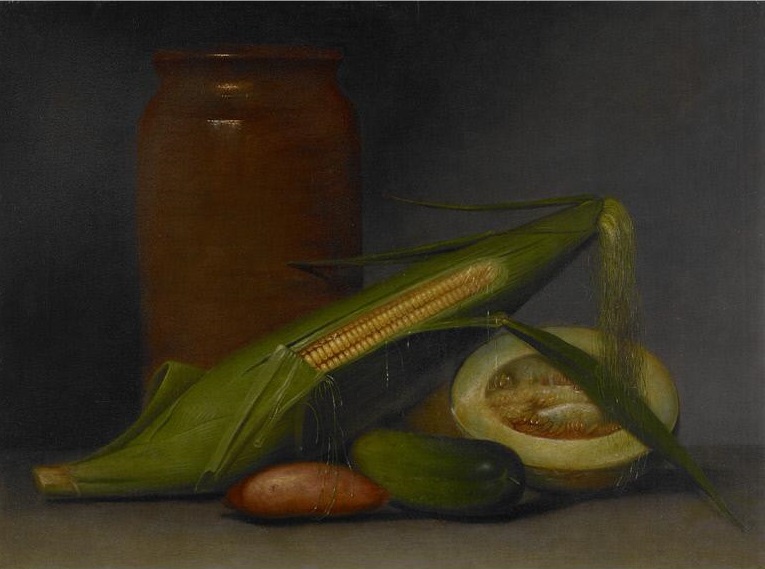On May 16, Crystal Bridges will present the last installation of the fascinating American Encounters exhibition series. This year’s exhibition, organized by the High Museum in Atlanta, focuses on still-life paintings and features two early European and eight American paintings. Like the three previous exhibitions, The Simple Pleasures of Still Life is a collaboration between Crystal Bridges; the High Museum in Atlanta, GA; The Terra Foundation for American Art in Chicago, IL; and the Musée du Louvre in Paris, France. The Simple Pleasures of Still Life explores the development and rise of American still-life painting during the 19th century, and analyzes the genre’s roots in the works of Dutch and French still-life masters of the seventeenth and eighteenth centuries. Works from the Crystal Bridges collection include Raphaelle Peale’s Corn and Cantaloupe (ca. 1813), John Haberle’s Small Change (1887), and De Scott Evans’ Daisies (ca. 1885).
Roots and growth: The term still life comes from the Dutch word stilleven which was introduced in the mid-seventeenth century to describe paintings of motionless objects from nature such as flowers, fruit, game, or everyday items. However, still-life painting was already practiced in ancient art, for example, in Egyptian murals, Roman mosaics, and on Greek vases. It then declined and did not re-emerge as an independent genre until the sixteenth century. Still-life painting as a specialty first flourished in the Netherlands during the early 1600s. Dutch artists were also the first to specialize in still lifes depicting objects with a symbolic content.
As still lifes rose in popularity in Europe, artists specialized in different types such as flower paintings, breakfast and banquet pieces (some of the latter can be very ostentatious), and animal still lifes. Many of these works are executed purely to demonstrate the technical virtuosity of the artist. However, many artists had a more complex message in mind and created paintings with a symbolic narrative, usually religious in nature. Among them are the so-called vanitas still lifes, which contain symbolic images such as skulls, extinguished candles, hourglasses, or butterflies to remind viewers of the transience of life and the triviality of material pursuits. A group of still lifes that became very popular in America during the late nineteenth century are trompe l’oeil or “fool the eye” paintings which are very illusionistic and give an appearance of three-dimensionality to its objects.

Fleurs dans une carafe de cristal placé sur un piédestal en pierre avec une libellule
Mignon Abraham (1637-1679)
Paris, musée du Louvre
Among the highlights of this exhibition is Flowers in a Crystal Vase, on a Stone Pedestal, with a Dragonfly, c. 1660-1670, a magnificent flower still life by Dutch artist Abraham Mignon (1640-1679). The painting’s grand manner composition was made to appeal to aristocratic taste; in fact Flowers in a Crystal Vase and another painting by Mignon were given to Louis XIV of France by Marquis de Beringhem—evidence of the artist’s fame and popularity at that time.[i] The painting, with its great variety of flowers and delicate brushwork, captures every detail of the hyperreal flowers, which seem to pop from the painting’s surface. Even though there is no skull, hour glass, or other obvious vanitas symbol, Mignon’s still life has certain elements that evoke this painting genre: some of the flowers bend, begin to fade, and lose some petals, which remind the viewer of the vanity of worldly things and the brevity of life. Mignon also included butterflies—a symbol of resurrection—and plants like wheat heads, referring to the Eucharistic Supper.
[i] Blaise Ducos, “Abraham Mignon, Flowers in a Crystal Vase Standing on a Stone Pedestal with a Dragonfly”, in American Encounters, The Simple Pleasures of Still Life, Stephanie Mayer Heydt et al. High Museum of Art (Seattle: Marquand Books, 2004), 32





